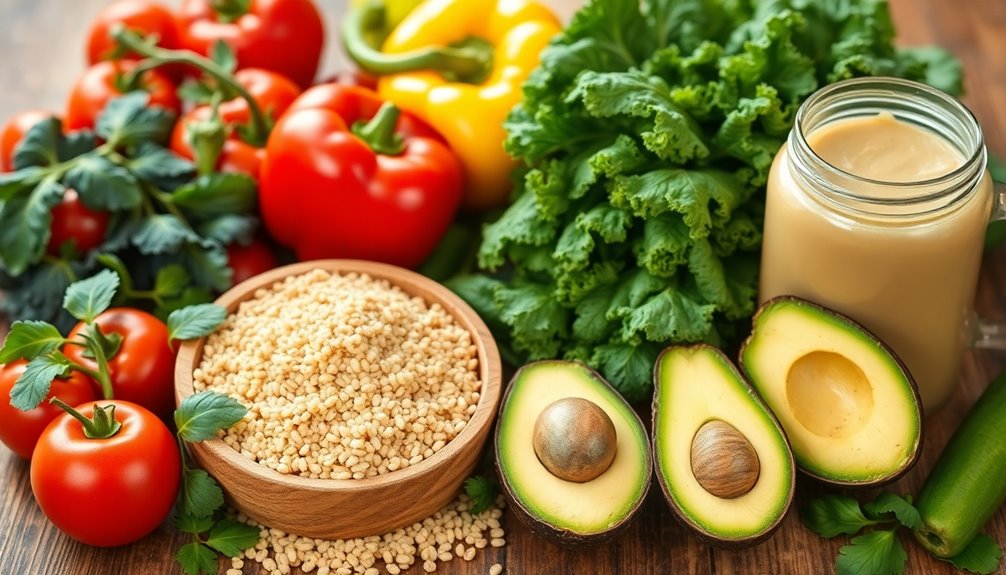A Whole-Food Plant-Based (WFPB) diet emphasizes eating unprocessed or minimally processed foods. You'll focus on fruits, vegetables, whole grains, legumes, nuts, and seeds, which provide essential nutrients to enhance your health. This approach can lower your risk of chronic diseases, aid in weight management, and boost your energy levels. It's not just about nutrition; it promotes community and connection with like-minded individuals. Making the change may involve initial challenges, but with determination and support, you can thrive on this vibrant diet. If you're curious about tips, recipes, and the broader benefits of a WFPB lifestyle, there's much more to explore.
Key Takeaways
- A Whole-Food Plant-Based (WFPB) diet emphasizes unprocessed or minimally processed foods, focusing on fruits, vegetables, whole grains, legumes, nuts, and seeds.
- This diet lowers the risk of chronic diseases, aids in weight management, and boosts energy levels with nutrient-rich foods.
- WFPB meals are diverse, delicious, and can be customized with various spices and cooking techniques, ensuring a fulfilling eating experience.
- Transitioning to a WFPB diet can be supported through community resources, meal planning, and gradual incorporation of whole foods into daily meals.
- Adopting a WFPB diet not only benefits personal health but also promotes environmental sustainability by reducing carbon footprints and supporting sustainable agriculture.
What Is a WFPB Diet?
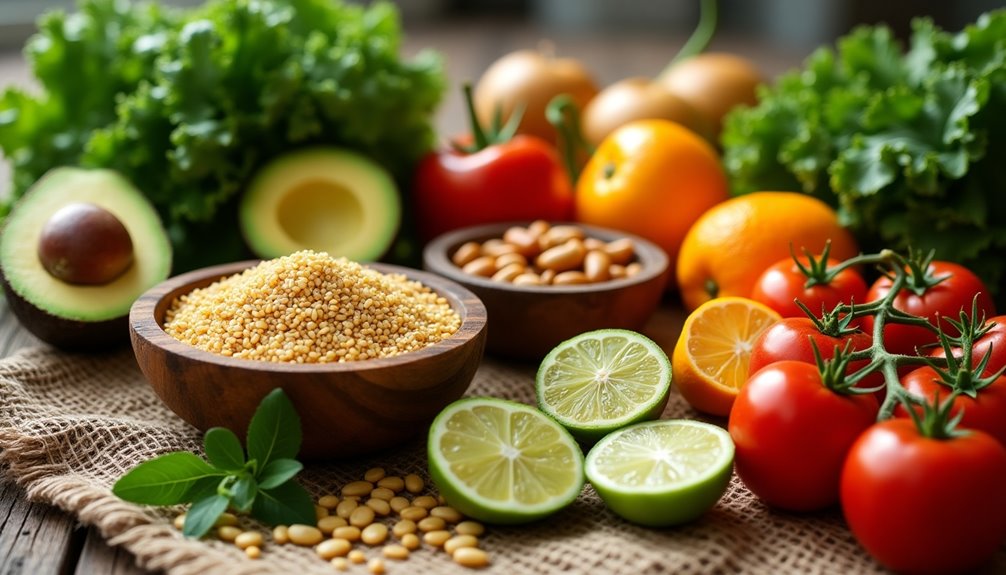
A Whole-Food Plant-Based (WFPB) diet focuses on consuming primarily unprocessed or minimally processed foods derived from plants. This diet emphasizes the importance of foods like fruits, vegetables, whole grains, legumes, nuts, and seeds. By prioritizing these nutrient-dense options, you're not just opting for a healthier lifestyle; you're also embracing a way of eating that fosters community and connection with others who share similar values.
One of the standout benefits of a WFPB diet is the sheer variety of flavors and textures it offers. You can enjoy a rainbow of fruits and vegetables, which not only makes your meals visually appealing but also guarantees you're getting a wide range of vitamins and minerals. This variety is key to feeling satisfied and nourished.
Moreover, focusing on whole foods means you're avoiding heavily processed ingredients often laden with additives, sugars, and unhealthy fats. This can result in improved energy levels and overall well-being. Eating nutrient-dense foods can help you maintain a healthy weight and provide the essential nutrients your body needs. Additionally, a WFPB diet is known to reduce the risk of heart disease, promoting better cardiovascular health.
Health Benefits of WFPB
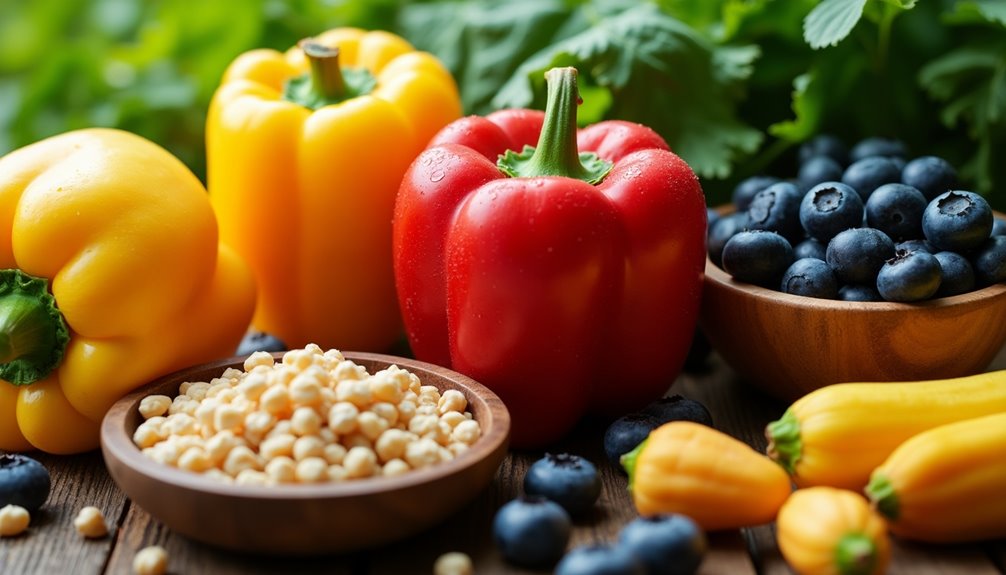
When you adopt a Whole-Food Plant-Based (WFPB) diet, you open the door to numerous health benefits that can greatly enhance your quality of life. This lifestyle choice not only promotes longevity benefits but also plays an essential role in disease prevention. Research indicates that a WFPB diet can lower the risk of chronic diseases like heart disease, diabetes, and certain cancers, giving you a solid reason to contemplate this approach.
Additionally, you may find that weight management becomes easier. Whole, unprocessed foods are often lower in calories and higher in nutrients, helping you feel fuller while consuming fewer calories. This can lead to sustainable weight loss and healthier body composition.
Energy levels can also see a significant boost. With the abundance of fruits, vegetables, whole grains, and legumes, your body receives the necessary nutrients it needs to function optimally. You might just notice that you feel more energized throughout the day, enhancing both physical and mental performance. Furthermore, adopting a WFPB diet aligns with plant-based diets that promote longevity and health improvements.
Here's a quick overview of the health benefits of a WFPB diet:
| Benefit | Description | Evidence |
|---|---|---|
| Longevity Benefits | Promotes longer life through reduced disease risk | Studies show lower mortality rates |
| Disease Prevention | Lowers risk of chronic illnesses | Research links WFPB to healthier outcomes |
| Weight Management | Aids in maintaining a healthy weight | Low-calorie, high-nutrient foods |
| Energy Levels | Increases overall energy and vitality | Nutrient-rich foods fuel better performance
Key Components of WFPB

Key components of a Whole-Food Plant-Based (WFPB) diet are essential to understanding how to make this lifestyle sustainable and effective. At its core, this diet emphasizes the consumption of whole foods—unprocessed or minimally processed plant foods that retain their natural nutrients. Think fresh fruits, vegetables, whole grains, legumes, nuts, and seeds. These foods aren't only rich in flavor but also packed with nutrients, making them crucial for your overall health.
One of the standout features of a WFPB diet is nutrient density. This term refers to the amount of essential nutrients per calorie in a food. By focusing on nutrient-dense whole foods, you're more likely to meet your body's nutritional needs without excessive calorie intake. This can lead to better energy levels, improved mood, and enhanced well-being.
Incorporating a variety of whole foods into your meals is vital. It's not just about eating more fruits and vegetables but also diversifying your choices to include different colors, textures, and flavors. This variety ensures you get a broad spectrum of vitamins, minerals, and antioxidants. Including protein-packed smoothies can further support your nutritional goals and provide an energy boost throughout the day.
Lastly, adopting a WFPB diet isn't just a personal journey; it fosters a sense of belonging to a community that values health, sustainability, and compassion. By sharing recipes and tips with others, you can inspire each other to stay committed to this enriching lifestyle. Embrace the journey, and enjoy the benefits of a vibrant, plant-based diet!
Common Misconceptions
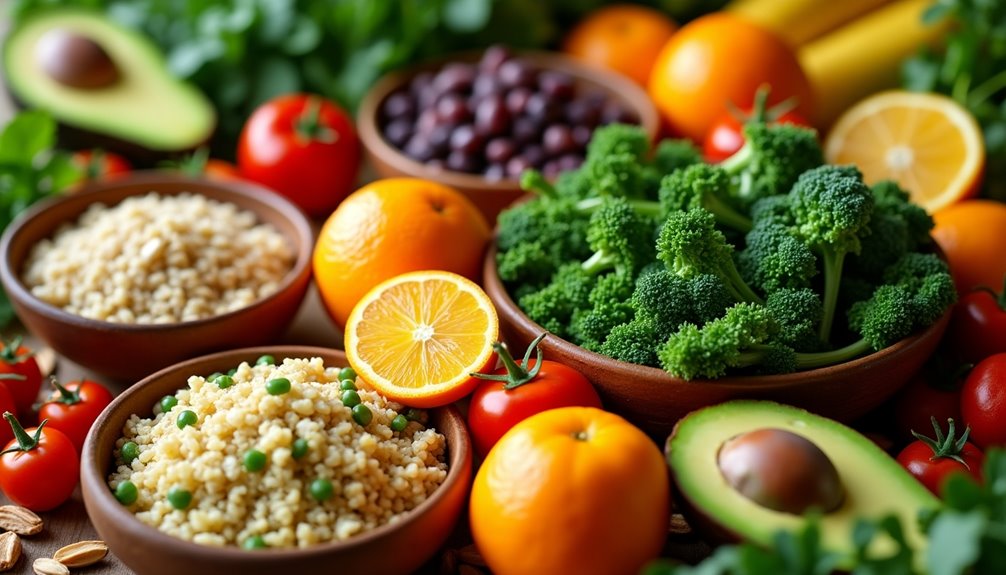
Many people hold misconceptions about a Whole-Food Plant-Based (WFPB) diet, often viewing it as overly restrictive or difficult to maintain. One common belief is that a WFPB diet leads to nutrient deficiencies. In reality, when you focus on a variety of whole foods—like fruits, vegetables, whole grains, legumes, nuts, and seeds—you can meet your nutritional needs quite effectively. For example, leafy greens and legumes are excellent sources of essential vitamins and minerals.
Another misconception is that a WFPB diet lacks sufficient protein sources. This simply isn't true. Many plant-based foods are rich in protein. Beans, lentils, quinoa, tofu, and tempeh are just a few examples of high-protein options available to you. If you diversify your meals, you'll easily get adequate protein without needing animal products.
Some people also fear that eating a WFPB diet will be bland or unexciting, but that couldn't be further from the truth. With the wide range of spices, herbs, and cooking techniques at your disposal, you can create delicious, satisfying meals that keep your taste buds engaged. Additionally, embracing a WFPB diet can provide you with access to online support community that can help you stay motivated on your journey.
Ultimately, embracing a WFPB diet doesn't mean you have to sacrifice flavor or health. You can enjoy a vibrant, nourishing lifestyle while feeding your body with the nutrients it needs. By dispelling these misconceptions, you'll find that a WFPB diet can be not only attainable but also enjoyable and fulfilling.
Transitioning to WFPB
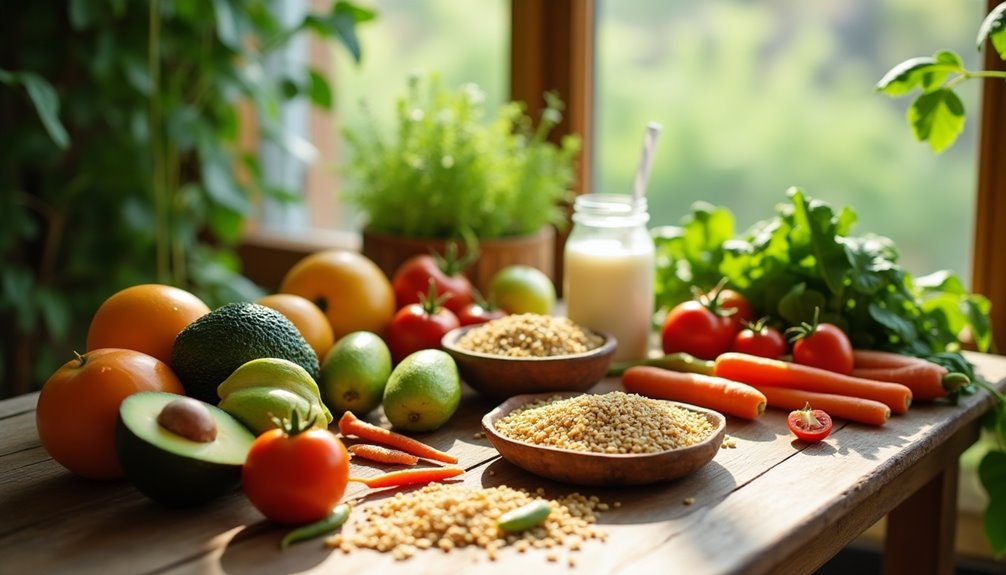
Shifting to a Whole-Food Plant-Based (WFPB) diet can feel challenging at first, but with the right approach, it becomes a manageable and rewarding journey. You might face initial challenges such as cravings for familiar foods or uncertainty about meal options. It's perfectly normal to feel overwhelmed, but remember, many others have successfully made this switch. Their success stories can serve as inspiration, showing that with determination, you can thrive on a WFPB diet.
To ease your adjustment, consider seeking social support. Connect with friends, family, or online communities who share your goals. They can provide encouragement, share recipes, and even join you in your journey, making the process less isolating. Look for local plant-based groups or social media platforms where you can exchange ideas and experiences.
Utilize available resources to help you along the way. Websites, cookbooks, and documentaries can offer practical tips and delicious recipes that align with your new lifestyle. Start small by incorporating more fruits, vegetables, whole grains, and legumes into your meals. Gradually reduce processed foods, and don't hesitate to experiment with new ingredients. Additionally, research has shown that a WFPB diet can significantly improve insulin sensitivity, which is crucial for managing blood sugar levels.
Lastly, be patient with yourself. Embracing a WFPB diet is a journey, not a race. Celebrate your progress, no matter how small, and remember that every positive change contributes to a healthier you. Embrace the community around you, and enjoy the adventure of discovering new flavors and nourishing your body.
Meal Planning Tips

Meal planning is an essential practice that can greatly simplify your shift to a Whole-Food Plant-Based (WFPB) diet. By organizing your meals ahead of time, you'll not only save time and money but also guarantee that you're eating a variety of nutritious foods. Start by dedicating a day each week to plan your meals. Consider breakfast, lunch, dinner, and snacks, making sure to include a mix of fruits, vegetables, whole grains, and legumes.
When grocery shopping, create a detailed list based on your meal plan. This helps you stay focused and avoid impulse buys, which can lead to unhealthy choices. Opt for seasonal produce to maximize flavor and nutrition while keeping costs down. Don't forget to explore bulk bins for grains and legumes, as they often provide cost-effective options.
To keep your meals exciting, search for flavorful recipes that align with your WFPB principles. Look for dishes that use herbs, spices, and diverse cooking techniques to enhance taste without relying on processed ingredients. Batch cooking can also be a game changer—prepare large quantities of staples like rice, beans, and roasted vegetables so you can quickly assemble meals throughout the week. Incorporating tools like mini bands for exercise can help maintain your fitness while following a WFPB diet.
Lastly, don't hesitate to share your meal plans and recipes with friends or family. Building a supportive community around your WFPB journey can make the shift smoother and more enjoyable. Embrace this process, and you'll soon find meal planning to be a rewarding part of your new lifestyle.
WFPB Recipes to Try

Exploring delicious Whole-Food Plant-Based (WFPB) recipes can be a rewarding way to embrace this lifestyle while satisfying your taste buds. You don't have to sacrifice flavor for health; in fact, WFPB meals can be both nutritious and incredibly tasty. Here are some flavorful dishes you can easily whip up in your kitchen.
| Dish | Easy Substitutions |
|---|---|
| Chickpea Salad | Replace chickpeas with black beans for a different texture. |
| Quinoa Stuffed Peppers | Swap quinoa for brown rice or barley for added nutrients. |
| Vegetable Stir-Fry | Use any seasonal veggies you have on hand; tofu can replace tempeh. |
| Banana Oatmeal Cookies | Substitute mashed bananas with applesauce for a different sweetness. |
These recipes highlight how you can make easy substitutions without losing flavor or nutrition. For instance, using different grains or beans can introduce new textures and tastes, making your meals exciting. Additionally, you can customize these recipes based on what you have in your pantry or local produce. Incorporating a variety of delicious recipes into your cooking can enhance your experience and keep your meals vibrant.
Don't hesitate to experiment—you'll find that the world of WFPB cooking is full of possibilities. By trying out these recipes, you'll not only enjoy delicious meals but also cultivate a sense of belonging within a community that values health and wellness. So grab your apron and get cooking; your taste buds—and your body—will thank you!
Environmental Impact

When considering your food choices, the environmental impact of a Whole-Food Plant-Based (WFPB) diet stands out as a substantial benefit. By opting for a diet rich in whole plants, you're not just nourishing your body, but also making a positive contribution to the planet. Studies show that plant-based diets can markedly reduce your carbon footprint compared to meat-heavy diets. This shift can help combat climate change and promote a healthier environment for future generations.
Sustainable agriculture practices are at the heart of WFPB eating. By focusing on fruits, vegetables, whole grains, legumes, nuts, and seeds, you're supporting farming methods that tend to use fewer resources and produce less waste. These practices help conserve water, protect biodiversity, and maintain healthy soils.
Plus, as you embrace a WFPB diet, you're encouraging local farmers and communities to grow more plant-based foods, fostering an ecosystem that prioritizes sustainability.
You might be surprised to learn that the production of animal products often requires considerably more land, water, and energy compared to growing plants. By choosing whole foods from plants, you're participating in a movement that promotes efficient use of resources and reduces environmental degradation. This shift not only benefits the planet but can also help address issues like snoring-related health risks, as certain diets have been linked to improved sleep quality.
Incorporating a WFPB diet into your lifestyle isn't just a personal health decision; it's a collective effort towards a more sustainable future. So, as you explore new recipes and ingredients, remember that each choice you make can have a profound impact on the world around you.
WFPB and Chronic Diseases

A Whole-Food Plant-Based (WFPB) diet can play a vital role in preventing and managing chronic diseases. By focusing on whole, unprocessed plant foods, you're not just making a lifestyle choice; you're actively working toward better health outcomes. Research shows that diets rich in fruits, vegetables, whole grains, nuts, and legumes can notably reduce the risk of chronic conditions like heart disease, diabetes, and certain cancers.
When you prioritize a WFPB diet, you're supporting your body's natural defenses. The high fiber content found in these foods promotes better digestion and helps maintain a healthy weight, both of which are essential for preventing chronic conditions. Antioxidants and phytochemicals abundant in plant foods can help combat inflammation and oxidative stress, two key contributors to many chronic diseases.
For those already managing a chronic condition, a WFPB diet can be an effective tool. Studies indicate that adopting this dietary approach can lead to improved disease management, often reducing the need for medication. You might find that your blood sugar levels stabilize, cholesterol drops, and blood pressure decreases—all through dietary changes. Moreover, managing underlying health conditions like high blood pressure can further enhance the benefits of a WFPB diet in supporting kidney health.
Joining a community that embraces a WFPB lifestyle can provide you with support and motivation. Sharing recipes, tips, and personal experiences can foster a sense of belonging. So, not only are you taking steps to prevent and manage chronic diseases, but you're also connecting with others on a similar journey toward health and wellness.
Frequently Asked Questions
Can Children Follow a Whole-Food Plant-Based Diet Safely?
Absolutely, children can follow a nutritious diet safely with proper planning. Pediatric nutrition experts emphasize the importance of balanced meals, ensuring they get all essential nutrients. School lunches can incorporate a variety of foods, like whole grains, fruits, and vegetables, to meet kids' needs. By focusing on diversity and nutrient density, you can help your child thrive while fostering a sense of belonging in their dietary choices, making healthy eating enjoyable and engaging.
What Are Some Common Nutrient Deficiencies in a WFPB Diet?
Ever feel like you're in a nutritional maze? When considering common nutrient deficiencies, you might encounter iron and vitamin B12 deficiencies, which are essential for energy and nerve health.
Ensuring adequate calcium and omega-3 levels is also critical for strong bones and heart health. By being proactive and incorporating fortified foods or supplements, you can navigate these challenges and enjoy a balanced, fulfilling diet that keeps you feeling your best.
How Does a WFPB Diet Impact Athletic Performance?
A diet rich in whole foods can greatly boost your athletic performance. It enhances your energy levels, enabling you to train harder and longer.
You'll likely experience improved endurance, which helps you push through tough workouts. Plus, the nutrient-dense foods support muscle recovery, allowing your body to heal efficiently after exertion.
Are There Any Specific Supplements Recommended for WFPB Eaters?
If you're following a plant-based diet, you might consider specific supplements to guarantee you're meeting your nutritional needs.
Vitamin B12 supplementation is often recommended, as it's primarily found in animal products.
Additionally, look for Omega 3 sources like algae oil, which can help support heart and brain health.
Can I Eat Out While Adhering to a WFPB Diet?
Sure, you can definitely eat out while sticking to your dietary choices! Many restaurants now offer plant-based options, so you can explore various cuisines.
When attending social gatherings, don't hesitate to ask hosts about the menu or suggest a dish you can bring. Look for salads, grain bowls, or veggie sides that align with your preferences.
With a little planning, you'll enjoy meals out without feeling left out or compromising your choices.
Conclusion
Incorporating a whole-food plant-based diet into your lifestyle can transform not just your health, but also the planet's well-being. By focusing on nutrient-dense foods, you'll reduce the risk of chronic diseases and promote sustainability—talk about a win-win! As you begin on this journey, remember that every small change counts. So, why not start today? Your future self (and the Earth) will thank you for making such a powerful choice.

